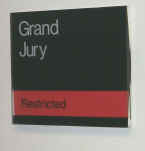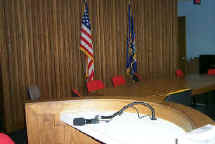|
Have you ever been on the Grand Jury?
On a trial jury?
Do you know how they differ?
In New York, the Grand Jury is the constitutional
right of the defendant; no one can be prosecuted for a felony unless the case is first
presented to the Grand Jury and an indictment returned, unless the defendant waives –
or gives up – that right. The Grand Jury is also in the U.S. Constitution for those
charged with federal crimes, and in many state constitutions, particularly those in the
East, which were the early English colonies. In other states, the police or prosecutor
file charges and there is no Grand Jury.
 |
Outside the Grand Jury
Room at the Clinton County
Government Center |
We "inherited" the Grand Jury from England
as a protection against the government. Originally, it prevented the King from ordering
citizens locked up without evidence. The Sheriff of Nottingham could not simply ride out
and arbitrarily arrest you.
Instead, the prosecutor must present evidence to a
group of 16 to 23 citizens, the Grand Jury, showing reasonable cause to believe that the
accused committed a felony. If at least 12 grand jurors find that there is reasonable
cause, the defendant is indicted.
The function of the Grand Jury is to protect against
the abuse of governmental power; it shields against arbitrary and groundless charges. This
is an important, but limited, protection.
The standard of proof for indictment: reasonable
cause, is less than that necessary for conviction after trial: proof beyond a reasonable
doubt. Because the purpose of the Grand Jury is different from that of the trial, or
petit, jury, the rights are fewer.
While a trial is open to the public, Grand Jury
proceedings are secret. This is to protect a defendant who is accused without sufficient
evidence. In New York, it is a crime for any member of the Grand Jury, the stenographer or
the prosecutor to reveal anything they learned in the Grand Jury.
Neither the defendant nor the defense attorney is
present while witnesses testify before the Grand Jury. Nor is there a judge. By law, the
District Attorney is the legal advisor to the Grand Jury. When a case is being presented,
the only people present are the Grand Jurors, the prosecutor and the stenographer, who
records all testimony and legal instructions.
The Clinton County
Grand Jury sits here. |
 |
Whenever a person is indicted, the defense
attorney makes motions challenging the indictment. The judge reads the transcript of the
proceedings prepared by the stenographer to determine if all legal requirements were
complied with and if there was sufficient evidence to indict. The rules of evidence apply
to Grand Jury presentations, so the prosecutor must be careful to allow only admissible
evidence and keep out hearsay. Any error may result in dismissal of the indictment,
eventhough there is no defense attorney there to object at the time.
 |
A view from the witness stand. |
|
|
When a witness testifies at the Grand Jury,
the prosecutor asks questions first, then members of the Grand Jury can ask questions, so
long as the legal and evidentiary rules are followed. Thus, it is a very interactive
process, unlike a jury trial. Grand Jurors can also take notes during the testimony and
legal instructions.
Only one witness at a time is present in the Grand
Jury Room; no witness hears the testimony of another. A witness who finishes testifying
leaves the Room, and the next witness enters and is sworn in to tell the truth.
The District Attorney issues subpoenas to require
witnesses to testify before the Grand Jury. Under New York law, when a witness is
subpoenaed, that witness is granted immunity. That is, because the witness is being
compelled to testify about what they know regarding a particular criminal incident,
nothing the witness says can be used to prosecute the witness. In New York, the immunity
is termed "transactional," and extends beyond simply a prohibition on using the
witness’ own words, to include immunity for any evidence that is uncovered because of
the witness’ testimony. Since there is immunity, the witness must testify. Refusing
to do so amounts to the felony of Contempt of the Grand Jury.
 |
The Foreperson, Clerk and
stenographer of the Grand
Jury sit at this table. |
The Grand Jury is independent of the District
Attorney, and can direct the DA to subpoena additional witnesses who have relevant
testimony. Anyone except the person accused can be subpoenaed; the New York and US
Constitutions guarantee our "privilege against self-incrimination." If a
defendant chooses to testify before a Grand Jury, the defendant must first sign a Waiver
of Immunity in front of the Grand Jury. Before doing so, the prosecutor advises the
defendant on the record that the Grand Jury is considering evidence against the defendant,
that he or she does not have to testify, asks if the defendant has consulted with an
attorney, and informs the defendant that he or she must sign a Waiver of Immunity and
acknowledge that whatever the defendant says can be used against him or her in any legal
proceeding.
A defendant who testifies after signing a Waiver of
Immunity has the right under New York law to have an attorney present in the Grand Jury
Room while testifying. However, the lawyer cannot ask questions nor make objections. The
defendant can consult with the attorney before answering any question.
The minimum number of people on a Grand Jury is 16
and the maximum is 23. Usually, 23 are sworn in at the beginning of a Grand Jury’s
term of service, which is three months in Clinton County. Fewer than 23 can hear evidence
in a specific case, but no less than 16. By law, it takes at least 12 votes to result in
an indictment, the document charging the defendant. This is so whether there are 16 or 23
present. Thus, with 23 Grand Jurors, the vote could be 12 to 11 and the defendant would be
indicted. If there are not 12 who vote to indict, the charge is dismissed; this is also
called a "no true bill of indictment."
Most of the time, a Grand Jury case consists only of
the evidence against a defendant. Sometimes this is because the case is a
"direct" Grand Jury presentation and the defendant is not aware of the charges.
Many times, the defendant does know of the Grand Jury case, but, on the advice of defense
counsel, chooses not to testify or ask the Grand Jury to call defense witnesses. A Grand
Jury case will usually last from about one to four hours each, so there will often be
several in a day. . . .
Grand Jurors do not go through voir dire, the
selection process used for trial juries. Since the proceedings are secret, the names of
the cases are not publicly announced. Therefore, when you are called for Grand Jury duty,
you do not know what cases you will hear. If, when you learn who a case is about, you
realize that you would not be able to decide the case solely on the evidence presented in
the Grand Jury because you already have knowledge about the alleged crime or the people
involved, you can ask the prosecutor to excuse you from that particular case.
In addition to hearing evidence of crimes and voting
whether or not to indict, the Grand Jury also has the authority to hear evidence
"concerning misconduct, nonfeasance and neglect in public office by a public
servant." In this regard, the Grand Jury may submit three kinds of reports to the
Court:
1) recommending removal or disciplinary action of the public servant;
2) "stating that after investigation, it finds no misconduct,
nonfeasance or neglect in office" by the public servant; or
3) "proposing recommendations for legislative, executive or
administrative action in the public interest based upon stated findings."
|